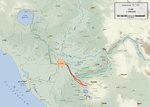Temple of Minerva Medica (nymphaeum)

The Temple of Minerva Medica is a ruined nymphaeum of Imperial Rome which dates to the 4th century. It is located between the Via Labicana and Aurelian Walls and just inside the line of the Anio Vetus. Once part of the Horti Liciniani on the Esquiline Hill, it now faces the modern Via Giolitti. It was once thought to be the temple to Minerva Medica ("Minerva the Doctor") mentioned by Cicero and other sources. The decagonal structure in opus latericium is relatively well preserved, though the full dome collapsed in 1828. It is surrounded on three sides with other chambers added at a later date. There is no mention of it in ancient literature or inscriptions. The structure represents a transition in Roman secular architecture between the octagonal dining room of the Domus Aurea and the dome of the Pantheon, and the architecture of nearby Byzantine churches. The diameter of the hall was about 24 meters, and the height was 33 meters — important from the structural point of view, especially for the ribs in the dome. In the interior, there are nine niches besides the entrance; and above these are ten corresponding round-arched windows. Both the interior and exterior walls were once covered with marble.In Flavio Biondo's 15th-century Roma Instaurata, these ruins are called Le Galluzze, a name of uncertain meaning that had been applied earlier to some ruins near the basilica of Santa Croce in Gerusalemme. Its misidentification as the Republican-era temple dates to the 17th century, based on the incorrect impression that the Athena Giustiniani had been found there.
Excerpt from the Wikipedia article Temple of Minerva Medica (nymphaeum) (License: CC BY-SA 3.0, Authors, Images).Temple of Minerva Medica (nymphaeum)
Via Pietro Micca, Rome Municipio Roma I
Geographical coordinates (GPS) Address External links Nearby Places Show on map
Geographical coordinates (GPS)
| Latitude | Longitude |
|---|---|
| N 41.893888888889 ° | E 12.511944444444 ° |
Address
Tempio di Minerva Medica (Tempio di Minerva)
Via Pietro Micca
00185 Rome, Municipio Roma I
Lazio, Italy
Open on Google Maps









